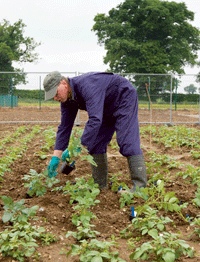GM approach would help solve potato problems

Transgenic approaches offer the potential for controlling both potato cyst nematodes and late blight, potato growers heard at the Cambridge University Potato Growers Research Association annual conference.
But stacking of different genetically modified traits might be needed to give sustainable control of potato cyst nematode.
Three approaches using genetic engineering techniques were outlined by Howard Atkinson from University of Leeds’ centre for plant sciences during a workshop session.
The first used a rice gene, already consumed by billions in their diets, which prevented nematodes from digesting proteins. This made the nematodes inefficient and reduced the rate at which they grew and reproduced – although it did stop initial feeding damage, Prof Atkinson explained.
In tests it had given around 80% control of potato cyst nematode.
A second strategy was being developed to stop nematodes initially feeding. Plants had been made that produced a compound that stopped nematodes from finding and invading the roots. Again that had given around 80% resistance.
But that wasn’t necessarily enough, even in combination with using rotational control, to prevent PCN from being damaging.
Some populations of one PCN species, Globodera pallida, only declined by 20-30% a year, he had earlier explained. “With those highly persistent populations, nematodes can still be damaging even with additional mortality of 90% from another control measure, such as nematicides, on top of control from rotations.
“Rotational control is not enough and chemical control, from which efficacy varies from 57% to 90%, is often not enough. It is why PCN is an increasing problem.”
However, stacking the two transgenic approaches together could give well over 90% control, and offered potential for more sustainable control, he believed.
The third transgenic approach involved turning the nematode against itself, using a technique called RNA interference. This involved engineering the plant to make double-stranded RNA, which, when the nematode ate it, caused it to think it was being infected by a virus and switch off its own gene coded for by the RNA, Prof Atkinson explained.
“The idea is to find a gene that the nematode needs to be a successful parasite. It is specific to each species and at the moment we haven’t found the right gene to get good control in PCN.”
Stacking multiple resistance genes was also the key to getting durable late blight resistance in potatoes, Cathie Martin, group leader of the department of cell and developmental biology at the John Innes Centre, told the conference.
Field trials by the John Innes Centre in Norfolk tested two genes inserted in Maris Piper and Desiree potatoes from a wild potato relative.
One gene was found to be completely susceptible to the blue-13 strain of blight that currently dominated in the UK, while the second was resistant, she said. “But it could be that it wouldn’t confer resistance to another strain, so we could need to stack multiple resistant genes.”
Funding was also being sought from the Technology Strategy Board to research stacking both nematode and blight resistance in varieties, Prof Atkinson added.
Biotechnology is much needed
Genetic engineering was a much needed technology for helping to improve potato production, according to speakers at the Cambridge University Potato Growers Research Association annual conference.
Potatoes had a huge number of quality traits – either external, internal or when processed – that could devalue the product, David Firman, head of potato agronomy at Cambridge University Farm, said.
“That makes it difficult for breeders. Clearly, GM has a place and could solve some of these issues; while using conventional breeding probably means us having to adapt our agronomy to deal with them.”
Using biotechnology could rapidly improve established varieties, Prof Martin said. As well as providing new solutions for problems for producers, it could also be used for consumer traits, such as increasing the nutritional value of potatoes.
“GM isn’t the only option, but to ignore the technology is to reject its potential for improvement. And it offers more than just herbicide tolerance and insecticide resistance.”
Europe must not fail to embrace biotechnology and GM crops, warned Tom Green, chief executive officer of Spearhead International.
His firm farms more than 70,000ha in the UK and Eastern Europe, with a particular focus on potatoes. Analysing how farming would meet the challenge of increasing global food production he pointed to the availability and uptake of new technology.
“Technology is most in mind when you think of GM. It is not a new technology – it is here and used elsewhere in the world.”
But Nick Vermont, regional chief executive of McCain Foods said while there had been some encouraging signs within governments about the sensible use of GM technology, no one in the industry “in their right minds” would launch a product in Europe until all stakeholders were in favour.

